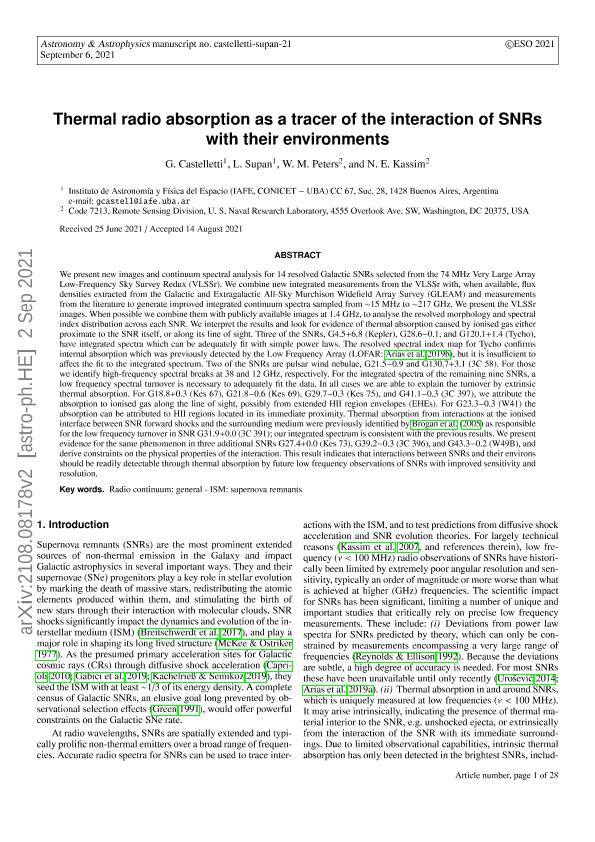Mostrar el registro sencillo del ítem
dc.contributor.author
Castelletti, Gabriela Marta

dc.contributor.author
Supán, Jorge Leonardo

dc.contributor.author
Peters, W. M.
dc.contributor.author
Kassim, N. E.
dc.date.available
2022-12-26T16:35:36Z
dc.date.issued
2021-09
dc.identifier.citation
Castelletti, Gabriela Marta; Supán, Jorge Leonardo; Peters, W. M.; Kassim, N. E.; Thermal radio absorption as a tracer of the interaction of SNRs with their environments; EDP Sciences; Astronomy and Astrophysics; 653; 9-2021; 1-28
dc.identifier.issn
0004-6361
dc.identifier.uri
http://hdl.handle.net/11336/182337
dc.description.abstract
We present new images and continuum spectral analysis for 14 resolved Galactic supernova remnants (SNRs) selected from the 74 MHz Very Large Array Low-Frequency Sky Survey Redux (VLSSr). We combine new integrated measurements from the VLSSr with, when available, flux densities extracted from the Galactic and Extragalactic All-Sky Murchison Widefield Array Survey and measurements from the literature to generate improved integrated continuum spectra sampled from ~15 MHz to ~217 GHz. We present the VLSSr images. When possible we combine them with publicly available images at 1.4 GHz, to analyse the resolved morphology and spectral index distribution across each SNR. We interpret the results and look for evidence of thermal absorption caused by ionised gas either proximate to the SNR itself, or along its line of sight. Three of the SNRs, G4.5+6.8 (Kepler), G28.6-0.1, and G120.1+1.4 (Tycho), have integrated spectra which can be adequately fit with simple power laws. The resolved spectral index map for Tycho confirms internal absorption which was previously detected by the Low Frequency Array, but it is insufficient to affect the fit to the integrated spectrum. Two of the SNRs are pulsar wind nebulae, G21.5-0.9 and G130.7+3.1 (3C 58). For those we identify high-frequency spectral breaks at 38 and 12 GHz, respectively. For the integrated spectra of the remaining nine SNRs, a low frequency spectral turnover is necessary to adequately fit the data. In all cases we are able to explain the turnover by extrinsic thermal absorption. For G18.8+0.3 (Kes 67), G21.8-0.6 (Kes 69), G29.7-0.3 (Kes 75), and G41.1-0.3 (3C 397), we attribute the absorption to ionised gas along the line of sight, possibly from extended H II region envelopes. For G23.3-0.3 (W41) the absorption can be attributed to H※ II regions located in its immediate proximity. Thermal absorption from interactions at the ionised interface between SNR forward shocks and the surrounding medium were previously identified as responsible for the low frequency turnover in SNR G31.9+0.0 (3C 391); our integrated spectrum is consistent with the previous results. We present evidence for the same phenomenon in three additional SNRs G27.4+0.0 (Kes 73), G39.2-0.3 (3C 396), and G43.3-0.2 (W49B), and derive constraints on the physical properties of the interaction. This result indicates that interactions between SNRs and their environs should be readily detectable through thermal absorption by future low frequency observations of SNRs with improved sensitivity and resolution.
dc.format
application/pdf
dc.language.iso
eng
dc.publisher
EDP Sciences

dc.rights
info:eu-repo/semantics/openAccess
dc.rights.uri
https://creativecommons.org/licenses/by-nc-sa/2.5/ar/
dc.subject
ISM: SUPERNOVA REMNANTS
dc.subject
RADIO CONTINUUM: GENERAL
dc.subject.classification
Otras Ciencias Físicas

dc.subject.classification
Ciencias Físicas

dc.subject.classification
CIENCIAS NATURALES Y EXACTAS

dc.title
Thermal radio absorption as a tracer of the interaction of SNRs with their environments
dc.type
info:eu-repo/semantics/article
dc.type
info:ar-repo/semantics/artículo
dc.type
info:eu-repo/semantics/publishedVersion
dc.date.updated
2022-09-23T10:08:56Z
dc.identifier.eissn
1432-0746
dc.journal.volume
653
dc.journal.pagination
1-28
dc.journal.pais
Francia

dc.description.fil
Fil: Castelletti, Gabriela Marta. Consejo Nacional de Investigaciones Científicas y Técnicas. Oficina de Coordinación Administrativa Ciudad Universitaria. Instituto de Astronomía y Física del Espacio. - Universidad de Buenos Aires. Facultad de Ciencias Exactas y Naturales. Instituto de Astronomía y Física del Espacio; Argentina
dc.description.fil
Fil: Supán, Jorge Leonardo. Consejo Nacional de Investigaciones Científicas y Técnicas. Oficina de Coordinación Administrativa Ciudad Universitaria. Instituto de Astronomía y Física del Espacio. - Universidad de Buenos Aires. Facultad de Ciencias Exactas y Naturales. Instituto de Astronomía y Física del Espacio; Argentina
dc.description.fil
Fil: Peters, W. M.. Spece Sciences División. Naval Research Laboratory; Estados Unidos
dc.description.fil
Fil: Kassim, N. E.. Spece Sciences División. Naval Research Laboratory; Estados Unidos
dc.journal.title
Astronomy and Astrophysics

dc.relation.alternativeid
info:eu-repo/semantics/altIdentifier/url/https://www.aanda.org/articles/aa/full_html/2021/09/aa41635-21/aa41635-21.html
dc.relation.alternativeid
info:eu-repo/semantics/altIdentifier/doi/http://dx.doi.org/10.1051/0004-6361/202141635
dc.relation.alternativeid
info:eu-repo/semantics/altIdentifier/url/https://arxiv.org/abs/2108.08178
Archivos asociados
